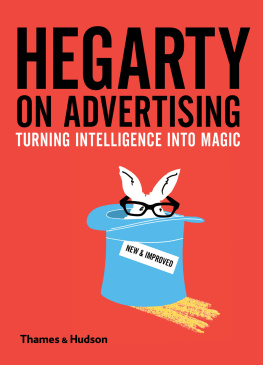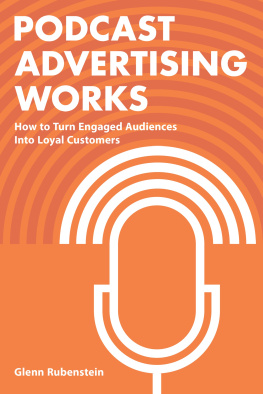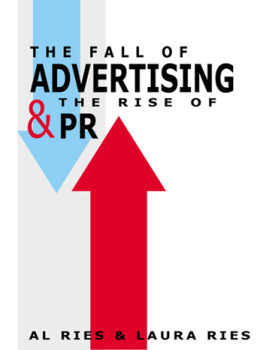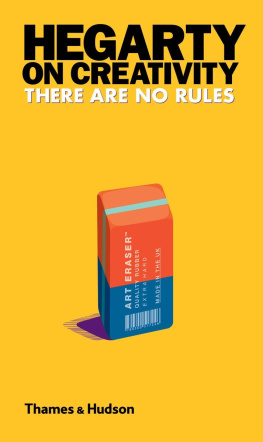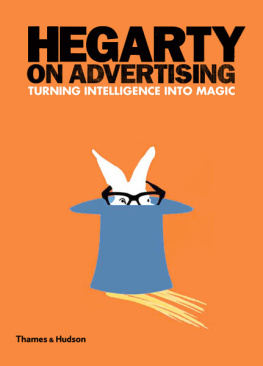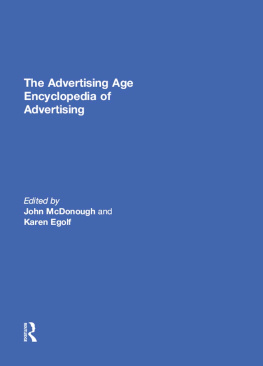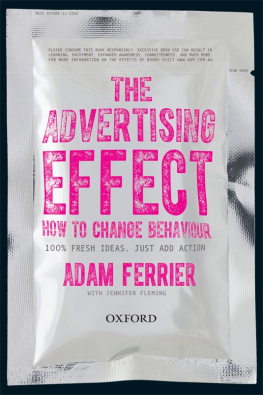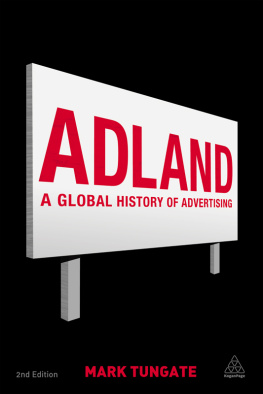
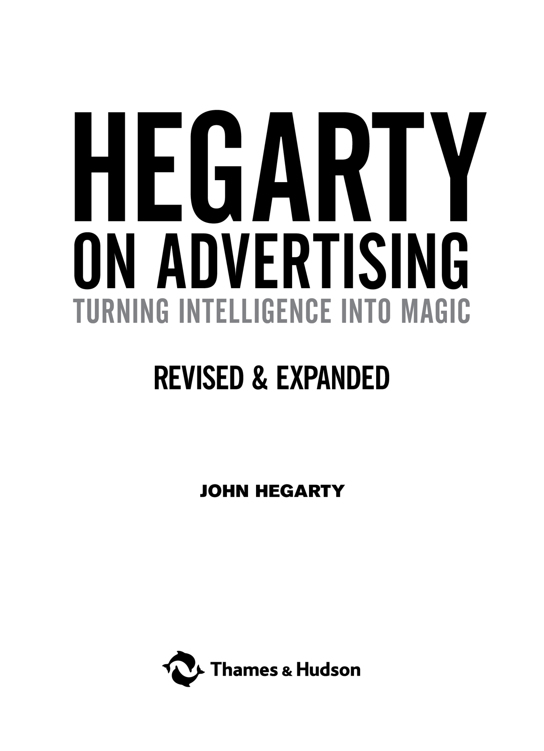
About the Author
John Hegarty is one of the worlds most celebrated advertising creatives. He was knighted in 2007 for services to advertising. Founding partner of Bartle Bogle Hegarty (BBH), he has received, among other awards, the D&AD Presidents Award for outstanding achievement, and has been inducted into both the New York Art Directors Club Hall of Fame and The One Club, as well as receiving a Clio Lifetime Achievement Award. In 2014 he co-founded The Garage Soho, a startup incubator.
Other titles of interest published by
Thames & Hudson include:
Hegarty on Creativity: There are No Rules
The Advertising Concept Book: Think Now, Design Later
Branding: In Five and a Half Steps
See our websites
www.thamesandhudson.com
www.thamesandhudsonusa.com
To Anne Hegarty, for being so inspiring
Contents
What makes advertising such a fascinating industry, and why does it have so much to teach us?
It is, of course, an essential component of any competitive market economy, driving growth and dynamism throughout its numerous industries. Its also everywhere. You cant escape it. And its unique in that you dont have to pay to see it its thrust upon you. And this can be a problem when so much of it is so poor. I suppose one could say the same about any creatively driven industry. How many good movies did you see last year?
But at its best, this unique mixture of art and commerce is engaging, entertaining and informative. Look at advertising from any era and you get a unique insight into society at that time: its loves, fears, wants and needs. It has to capture the zeitgeist sometimes reflecting it and sometimes, as with our Levis advertising, helping to create it.
Its an industry that is constantly moving forward. Yesterdays idea is exactly that yesterdays. Whats new? Whats next? How can one brand gain competitive advantage over another? These are the forces that drive us from one day to the next. And whatever you do in our industry, from creative to planning, to account handling, to media thinking, youll find exciting, funny, knowledgeable and stimulating people. Its an industry made of entrepreneurs. Its also an industry that will prepare you for almost any other business: its fast moving, challenging, smart and inquisitive, built on the need for competitive advantage.
Its also one of the most egalitarian industries in which you can work. No one cares where you were born, where you went to school or who you do or dont know. Just think, two boys born in Baghdad to Iraqi Jewish parents became two of the most powerful people in the UK. Youve all heard of Maurice and Charles Saatchi. This industry cares for only one thing: ideas. And have you got any?

John Hegarty, 2017
Photographer: Opal Turner
It was Andrew Sanigar at Thames & Hudson who suggested I embark on this endeavour. Initially I said, You must be joking Im an art director, not a writer. No problem, he said, well only need about 60,000 words. 60,000 words! I exclaimed. Ive spent most of my life trying to make things shorter, not longer. Creativity in advertising is all about the power of reduction. Write less, say more. 60,000 words does not sound like less to me.
As you can see, I succumbed. I remembered some wise words from the author Frank Delaney, who, after meeting me, said, So John, when are you going to write your book? I replied with my stock answer: Im an art director I do the pictures. Frank looked at me somewhat puzzled and said, But John, writing is just describing pictures. I was reminded of these words of wisdom as I said yes and put pen to paper. Writing is really just a series of linked-up images.
After 50 years in the business Id seen and experienced a fair amount that just might be interesting to the odd student of advertising. And not just advertising, but business. I was at the forefront of the creative revolution that swept through the boardrooms of our industry, destroying many and promoting others. A unique period of change and innovation that broke down barriers and captured the publics imagination, creating famous brands and making and breaking governments, while also witnessing Britain emerge as a creative powerhouse in the world.
I reckoned that might be worth a comment or two.
But why write a book on advertising now? Or why bother updating it? Surely advertising is an industry that is under threat, its future in certain doubt? Belief and confidence are collapsing all around us. Headlines in the media constantly predict advertisings imminent passing, as others gloat over its inability to cope with the digital age.
Old media is being dealt body blows as the impact of new technology sweeps all before it. The four horsemen of the apocalypse digital, free, customization and search pronounce the impending doom. You can either slash your wrists now or download some Leonard Cohen. His Bird on the Wire might do the trick!
Our industry is evolving and it is doing so at an ever greater speed. It is said that a week in politics is a long time. Im beginning to feel that its like that in our business too. Take the development occurring in posters, one of the oldest forms of advertising. The conversion to digital boards will transform this medium. Imagine you can change your message at the touch of a button just think of all the creative possibilities it opens up.
I think all this makes it the perfect moment to comment on the advertising industry. Under threat it most certainly is, but unlike other creative industries, advertising is always under threat. Innovation in both business philosophy and technology is always a challenge, and advertising continuously has to rise to those challenges thats what makes it so exciting.
Photography was supposed to put paid to painting, as television was going to kill both radio and the cinema. The doom-mongers have said the web is going to destroy television, just as it is doing with newspapers in the form of free news sites. But it hasnt: television is booming.
Ironic, isnt it, that the word free, supposedly the most powerful word in the lexicon of advertising, could be the word that destroys it?
Well, maybe not.
But rather than debate the state of the advertising industry, we should look at what is happening to the brands. And how they are having to behave in this evolving digital, social networking world. The function of advertising is simply to promote and sustain competitive advantage for brands. So the key to the future is how the public are going to interact with them.
You could say that today were all in the fashion business. As function fades into the background we expect things to work properly. In fact, not only expect it, but actually demand that they do. When was the last time your car broke down? These days you dont even have to go to the garage for a service. The function of an object is now taken for granted, so our concern shifts from function to form. We want it to look right. Just as you buy the latest fashion, so you can equip your home with the must-have gadgets. Brands such as Alessi are as much in the fashion business as they are in the appliance industry. Today, a products emotional appeal is as important as its functional abilities. The food we eat, the kitchens we cook in, the places we live, the holidays we take and the cars we drive have to look and feel right as much as they have to perform.
Next page
